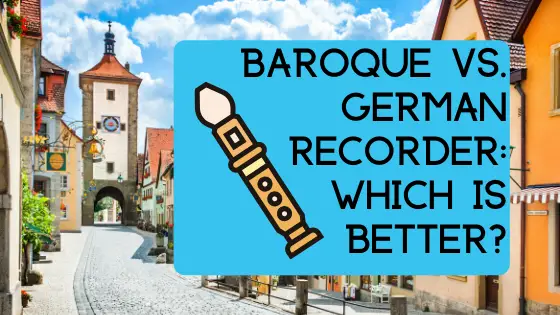Have you heard the words baroque and German recorder tossed around, but you’re not sure what it means?
I didn’t totally understand the difference myself at first until I became a music teacher and looked into it.
I saw this subject debated by my music teachers and wondered by students, so I decided to weigh in on the baroque vs. German recorder debate.
The baroque recorder features a small 4th hole and a large 5th hole which makes the note F appear out of natural order with the fingerings. However, the fingerings for F# and Bb are easier, and the fingerings transfer smoothly between sizes. German recorders use a large 4th hole and small 5th hole which keeps a logical fingering order for F but adds a tricky fingering for F# and Bb.
Look ahead for a detailed discussion and my personal verdict below.
Table of Contents
What Is A Baroque Recorder?
The baroque recorder is the traditional recorder you think of when you picture or see a recorder.
It’s much more common than the German recorder.
The difference between the two isn’t on size, but on design.
The baroque recorder’s design goes back to the Baroque musical period during the recorder’s most popular days.
The defining feature of this design is in the 4th and 5th holes.
Baroque recorders use a small 4th hole and a large 5th hole.
Without getting into the specifics of extreme mathematical acoustic calculations, this design does several important things.
First and most noticeably, the note F (natural) loses the sequential fingering pattern.
For all natural notes up to and excluding F, the fingerings just add another note.
- B = thumb, 1
- A = thumb, 1, 2
- G = thumb, 1, 2, 3
- F = thumb, 1, 2, 3, 4, 6, 7
- E = thumb, 1, 2 3, 4, 5
- D = thumb, 1, 2, 3, 4, 5, 6
- C = thumb, 1, 2, 3, 4, 5, 6, 7
For a visual, check out our recorder fingering chart for beginners.
This sounds like a big pain when it comes to teaching and playing.
To be honest, this is the reason why some people opt for using German-style recorders.
Other Pluses For Baroque Recorders
But it’s important for you to be aware of the positives too.
The baroque style also results in easier accidental fingerings. This is especially true with F# and Bb, but the others are easier as well.
The other main plus is how all baroque recorders use the same fingerings for all notes regardless of size.
An F# on soprano is the same as an F# on tenor. No need to learn anything new, just pick it up and go.
From my own experience, the accidental pitches (all flats and sharps) tend to be more in tune with baroque recorders.
This is clearly the case with lower end, student models, but it’s evident in higher-end models as well, though to a lesser degree.
What Is A German Recorder?
German recorders come from…you guessed it… Germany.
These recorders use a large-small pattern for the 4th and 5th holes on their recorders.
The German recorder was designed specifically to be easier to learn for new players.
As a result of its design, all natural pitches are fingered sequentially.
- B = thumb, 1
- A = thumb, 1, 2
- G = thumb, 1, 2, 3
- F = thumb, 1, 2, 3 4
- E = thumb, 1, 2 3, 4, 5
- D = thumb, 1, 2, 3, 4, 5, 6
- C = thumb, 1, 2, 3, 4, 5, 6, 7
This takes away almost any struggle for new players to learn how to finger this note. Switching between diatonic pitches becomes much more simple and logical for new players.
This logical pattern follows on the different sizes of German recorders.
However, the accidentals for these recorders get all messed up as a result.
F# The German soprano recorder goes to the thumb, 1, 2, 3, 5, 6, (half hole) 7 for perfect tuning.
Bb on the German soprano recorder goes to thumb, 1, 3, 4, 6.
Beyond these common accidentals are even more half coverings and skipping fingers.
Worse, when you learn these on a soprano recorder, they’re all different depending on the other sizes.
Sheet music stays the same for all soprano recorders too regardless of baroque or German design. But the fingerings and help offered by the resources are almost exclusively baroque.

Baroque Vs. German Recorder: Head To Head
Putting them together head-to-head, here’s what you have.
| Feature | Baroque | German |
| 4th hole-5th hole size order | small-large | large-small |
| F fingering | Thumb, 1, 2, 3, 4, 6, 7 | Thumb, 1, 2, 3, 4 |
| F# and Bb fingering | Fairly simple | More complicated |
| Tuning | In tune across accidentals | Loses pitch across accidentals |
| Consistency across sizes | Same fingers for all recorders | Different for each size |
| Available resources | Tons of resources | Very few |
| Good Keys To Play In | C, F, G (others are OK) | C, F (G is OK, others are hard) |
Related Questions
What’s The Difference Between an Alto And Soprano Recorder? – The alto and soprano are different sizes with usually the same fingerings.
The alto starts on F4 while the soprano starts on C5.
The alto requires a larger hand while a soprano is good for small ones.
Read more about alto vs. soprano recorder.
Are Wooden Recorders Better Than Plastic Ones? – By and large, yes.
Wooden recorders cost more and are more sensitive to changes in weather, but the tone quality is head and shoulders better.
This doesn’t mean plastic ones sound bad, but they have a hard time matching the richness of tone.
Learn about the best soprano recorder brands.
Is Recorder A Serious Instrument? – Yes, it is.
The strongest connection people have with recorders is in elementary school. Few people stick with it long enough to show how serious it is.
The recorder is most popular with Renaissance and Baroque periods of music, but good players enjoy covering modern music as well on the recorder.
Final Thoughts
I hope you found this information on baroque vs. German recorders as interesting as I did.
In terms of which is better, it’s up to you, but I believe the baroque design is best for kids and adults.
It transfers better to other recorders. Though F is tougher, the other accidentals are easier.
The resources out there also focus on baroque fingerings as well.
Whichever you decide to do, it’s a fun instrument to play and learn, so I encourage you to pick one up and give it a shot!

